Degenerative Disc Disease Treatment Market Research, 2032
The global degenerative disc disease treatment market size was valued at $28 billion in 2022, and is projected to reach $46.2 billion by 2032, growing at a CAGR of 5.5% from 2023 to 2032. Minimally invasive surgical techniques have emerged as a major driving force behind the growth of the degenerative disc disease (DDD) treatment market. These innovations offer significant benefits, leading to increased adoption and degenerative disc disease market expansion.
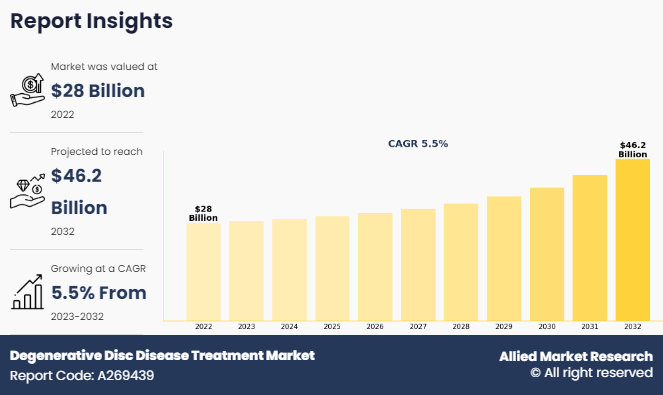
Degenerative disc disease (DDD) is a condition characterized by the breakdown of intervertebral discs in the spine. These discs act as cushions between the vertebrae, providing support and flexibility to the spine. With DDD, these discs lose hydration, elasticity, and shock-absorbing capabilities, leading to symptoms like pain, stiffness, and reduced mobility in the affected area. Over-the-counter or prescription medications such as nonsteroidal anti-inflammatory drugs (NSAIDs), acetaminophen, or muscle relaxants may help alleviate pain and inflammation associated with DDD. Exercises and stretches prescribed by a physical therapist can strengthen the muscles supporting the spine, improve flexibility, and alleviate pressure on affected discs.
Market Dynamics
Minimally invasive procedures generally require smaller incisions, leading to less tissue damage and quicker healing. This allows patients to return to their normal activities faster compared to traditional open surgeries, making these techniques more attractive. Smaller incisions reduce the risk of complications such as infection, bleeding, and postoperative pain. This lower risk profile encourages more patients to opt for surgical intervention when necessary.
Additionally, Innovations in imaging technology and surgical tools have enhanced the precision of minimally invasive techniques. Surgeons can use advanced equipment like endoscopes and robotic-assisted systems to improve accuracy, leading to better surgical outcomes and patient satisfaction.
Surgical procedures like discectomy and artificial disc replacement are commonly recommended by surgeons for patients who do not respond to medication or therapeutic injections for degenerative disc disease. The increasing number of approvals and launches of implants by market players to meet patient demand also limits the adoption of drugs for this condition. As a result, the availability of various alternative treatment and pain management methods, along with ongoing advancements in these methods, is anticipated to impede the degenerative disc disease treatment market growth.
Ongoing research and development efforts are leading to advancements in treatment modalities for degenerative disc disease. This includes the development of innovative surgical techniques, minimally invasive procedures, and novel pharmacological approaches, all of which offer new opportunities for degenerative disc disease treatment industry growth.
Pharmaceutical companies and medical device manufacturers are continually expanding their product portfolios to address the diverse needs of patients with degenerative disc disease. This includes the development and commercialization of new drugs, biologics, implants, and medical devices tailored to different stages and manifestations of the disease. Advances in medical technology, such as robotics, 3D printing, and advanced imaging techniques, are enhancing the precision, safety, and efficacy of degenerative disc disease treatments. These technological innovations are opening up new avenues for market expansion and differentiation among market players.
In January 2023, DiscGenics, Inc. revealed that the Injectable Disc Cell Therapy (IDCT), also known as rebonuputemcel, received the Regenerative Medicine Advanced Therapy (RMAT) designation from the U.S. FDA. This designation acknowledges the innovative nature of IDCT, an injectable, allogeneic discogenic progenitor cell therapy designed to address symptomatic lumbar degenerative disc disease (DDD). The FDA's recognition represents a significant endorsement of DiscGenics' unique strategy, which involves utilizing a manufactured live progenitor cell population sourced from donated adult human intervertebral disc tissue to combat disc degeneration. This achievement positions the company with a competitive edge in the field.
Segments Overview
The degenerative disc disease treatment market is segmented on the basis of drugs, treatment type, end use, route of administration and region. By drugs, the market is sub-segmented into acetaminophen, NSAIDS (non-steroidal anti-inflammatory drugs), muscle relaxants, and steroids. By treatment type, the market is classified into occupational therapy, physical therapy, special exercises, medications, and weights loss surgery. By end use, the market is classified into hospitals, clinics, and others. By route of administration, the market is classified into oral, and injectable. By region, the market is analyzed across North America, Europe, Asia-Pacific, and LAMEA.
By Drugs
The NSAIDs (non-steroidal anti-inflammatory drugs) sub-segment dominated the degenerative disc disease market in 2022. NSAIDs are highly effective at reducing pain, inflammation, and fever, making them a popular choice for the management of various conditions such as arthritis, musculoskeletal injuries, and menstrual cramps. NSAIDs are available over-the-counter (OTC) in many countries, making them easily accessible to consumers without the need for a prescription. This accessibility contributes to their widespread use for self-medication and minor ailments.
NSAIDs can address multiple symptoms simultaneously, such as pain and inflammation. This overlapping indication allows for simplified treatment regimens and reduces the need for multiple medications for symptom management.
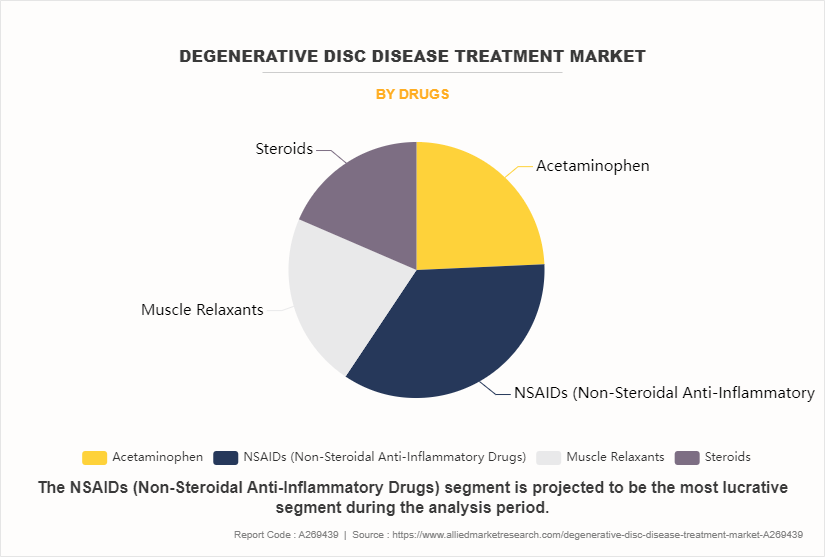
By Treatment Type
The physical therapy sub-segment dominated the global degenerative disc disease treatment market share in 2022. Physical therapy offers a non-invasive treatment option for degenerative disc disease, making it appealing to patients who prefer conservative management before considering more invasive interventions such as surgery. This non-invasive approach aligns with the preferences of many patients and healthcare providers alike.
Physical therapy has been shown to be highly effective in reducing pain, improving mobility, and enhancing function in individuals with degenerative disc disease. Therapeutic exercises, manual therapy techniques, and modalities such as ultrasound and electrical stimulation can help strengthen muscles, improve flexibility, and alleviate pressure on affected discs, leading to symptom relief and improved quality of life.
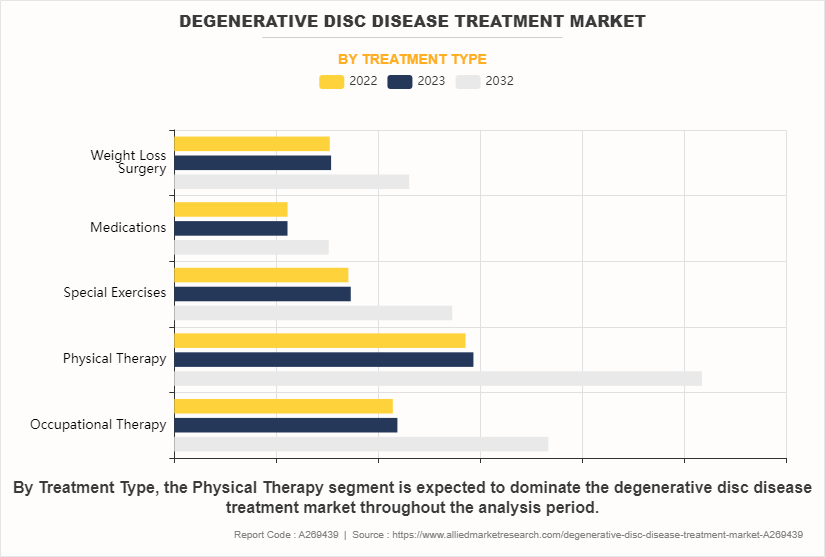
By End Use
The hospitals sub-segment dominated the global degenerative disc disease treatment market share in 2022. Hospitals typically have specialized departments or units dedicated to orthopedics, neurology, or spine care, equipped with advanced diagnostic tools and treatment modalities specifically tailored to managing degenerative disc disease. This specialized infrastructure enables hospitals to provide comprehensive care to patients with complex spinal conditions, including degenerative disc disease.
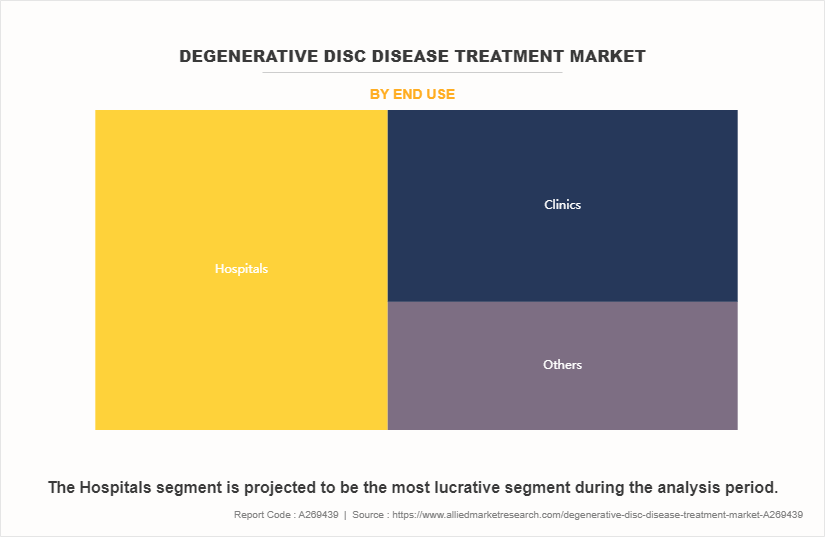
By Route of Administration
The oral sub-segment dominated the global degenerative disc disease treatment market size in 2022. Oral medications are convenient and easy to administer, making them a preferred choice for many patients and healthcare providers. Patients can take oral medications at home without the need for medical supervision, allowing for greater flexibility in managing their condition. Oral medications for degenerative disc disease, such as nonsteroidal anti-inflammatory drugs (NSAIDs), muscle relaxants, and analgesics, are widely available over-the-counter or with a prescription. This widespread availability ensures accessibility for patients in various healthcare settings, including hospitals, clinics, and pharmacies.
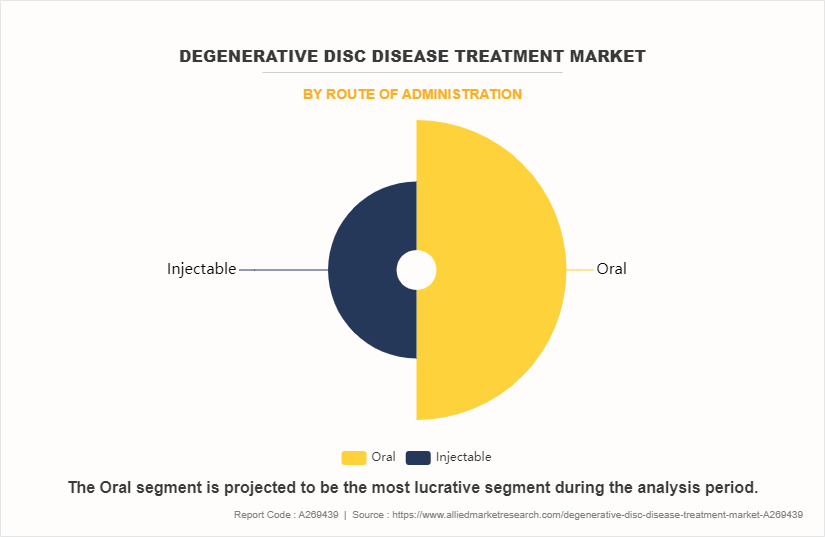
By Region
North America dominated the global degenerative disc disease treatment market in 2022. The North American degenerative disc disease treatment industry is influenced by several factors, including advancements in medical technology, increasing healthcare expenditure, growing awareness among patients, and the rising prevalence of DDD due to aging populations and sedentary lifestyles.
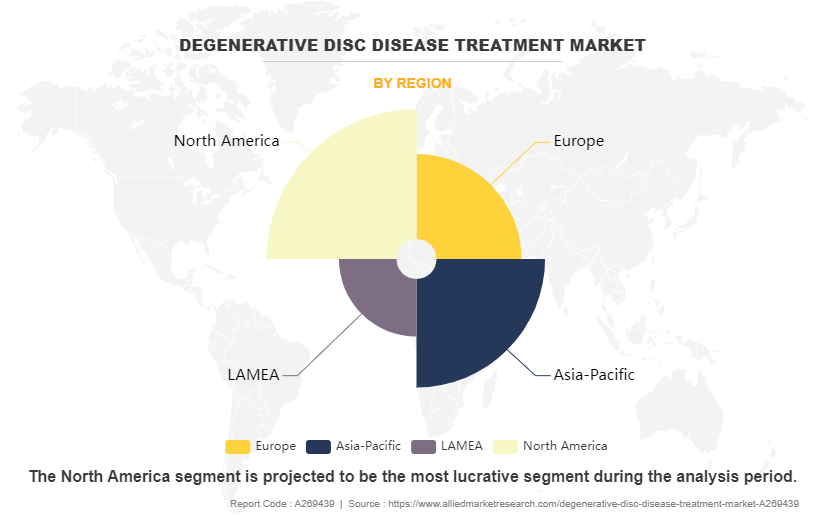
The development of minimally invasive surgical techniques, such as artificial disc replacement and spinal fusion, has revolutionized DDD treatment. These advancements offer reduced recovery times, less post-operative pain, and better outcomes for patients. The aging population in North America is more susceptible to DDD due to the natural degeneration of spinal discs over time. As the baby boomer generation ages, the prevalence of DDD is expected to rise, driving demand for treatment options.
Competitive Analysis
The key players profiled in this report include Medtronic plc, Johnson & Johnson Services, Inc., Zimmer Biomet Holdings, Inc., Stryker Corporation, Abbott Laboratories, Pfizer Inc., Novartis AG, AstraZeneca plc, Merck & Co., Inc., and Eli Lilly and Company. Investment and agreement are common strategies followed by major market players. For instance, in March 2022, Spine BioPharma Inc received USD 13 million series B round of funding for injectable treatment for degenerative disc disease. This funding helped the company to develop SB-01 treatment, a first-in-class therapeutic for the treatment of degenerative disc disease, thereby drive revenue growth.
Key Benefits for Stakeholders
- This report provides a quantitative analysis of the market segments, current trends, estimations, and dynamics of the degenerative disc disease treatment market analysis from 2022 to 2032 to identify the prevailing degenerative disc disease treatment market opportunity.
- The market research is offered along with information related to key drivers, restraints, and opportunities.
- Porter's five forces analysis highlights the potency of buyers and suppliers to enable stakeholders make profit-oriented business decisions and strengthen their supplier-buyer network.
- In-depth analysis of the degenerative disc disease treatment market segmentation assists to determine the prevailing market opportunities.
- Major countries in each region are mapped according to their revenue contribution to the global market.
- Market player positioning facilitates benchmarking and provides a clear understanding of the present position of the market players.
- The report includes the analysis of the regional as well as global degenerative disc disease treatment market trends, key players, market segments, application areas, and market growth strategies.
- Based on drugs, the NSAIDs (non-steroidal anti-inflammatory drugs) sub-segment emerged as the global leader in 2022 and is anticipated to be the fastest growing sub-segment during the degenerative disc disease treatment market forecast period.
Degenerative Disc Disease Treatment Market Report Highlights
| Aspects | Details |
| Market Size By 2032 | USD 46.2 billion |
| Growth Rate | CAGR of 5.5% |
| Forecast period | 2022 - 2032 |
| Report Pages | 320 |
| By Drugs |
|
| By Treatment Type |
|
| By End Use |
|
| By Route of Administration |
|
| By Region |
|
| Key Market Players | Medtronic plc, Ferring B.V., Braun Melsungen AG, Pfizer Inc., AstraZeneca Plc, FibroGenesis, Novartis AG, Eli Lilly and Company, Spine BioPharma, DiscGenics, Inc. |
The aging population is more prone to degenerative conditions like DDD. As life expectancy increases globally, the prevalence of DDD is expected to rise, driving demand for treatment options. Advances in medical technology, including minimally invasive surgical techniques, robotics, and advanced imaging modalities, are improving the diagnosis and treatment of DDD. These advancements offer more precise and effective interventions, leading to better patient outcomes and shorter recovery times.
The major growth strategies adopted by degenerative disc disease treatment market players are investment and agreement.
North America is projected to provide more business opportunities for the global degenerative disc disease treatment market in the future.
Medtronic plc, Johnson & Johnson Services, Inc., Zimmer Biomet Holdings, Inc., Stryker Corporation, Abbott Laboratories, Pfizer Inc., Novartis AG, AstraZeneca plc, Merck & Co., Inc., and Eli Lilly and Company are the major players in the degenerative disc disease treatment market.
The NSAIDs (Non-Steroidal Anti-Inflammatory Drugs) sub-segment of the deployment model acquired the maximum share of the global degenerative disc disease treatment market in 2022.
Individuals suffering from DDD are the primary customers of the DDD treatment market. Patients seek effective treatments to alleviate symptoms such as chronic back pain, stiffness, and reduced mobility. They may explore various treatment options, including conservative measures, minimally invasive procedures, and surgical interventions, to manage their condition and improve their quality of life.
The report provides an extensive qualitative and quantitative analysis of the current trends and future estimations of the global disc disease treatment market from 2022 to 2032 to determine the prevailing opportunities.
Loading Table Of Content...
Loading Research Methodology...



